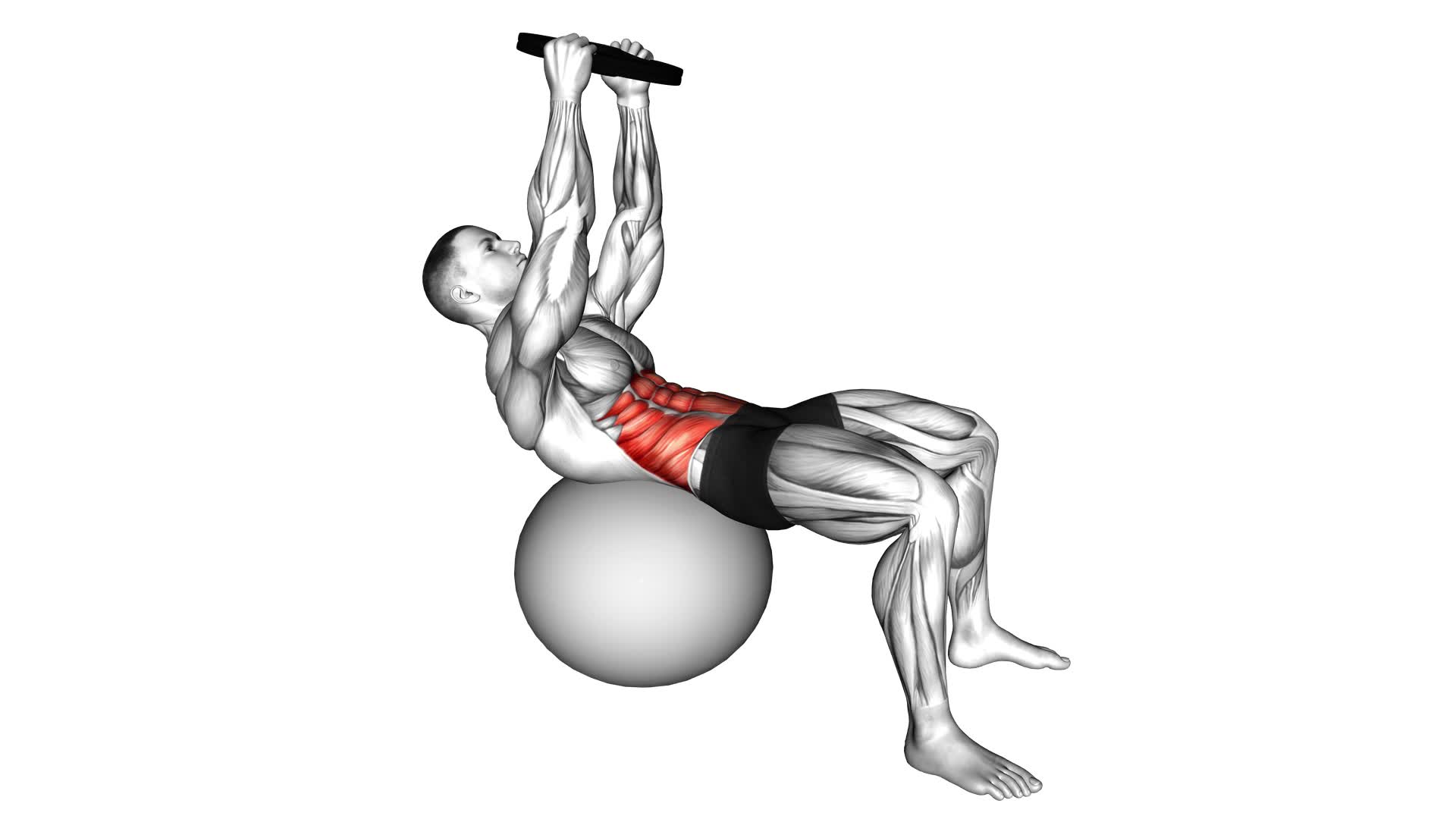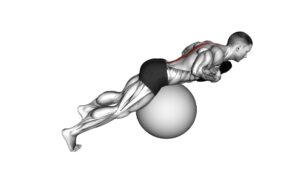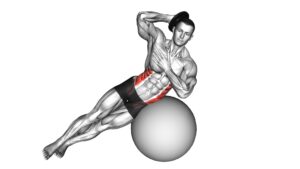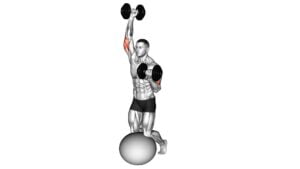Weighted Overhead Crunch (On Stability Ball) – Video Exercise Guide & Tips

Are you looking for an effective exercise to target your core muscles? Look no further than the Weighted Overhead Crunch on a Stability Ball.
Watch This Exercise Video
This exercise not only engages your abs but also challenges your stability.
In this video exercise guide, you'll learn the proper form and technique, as well as variations and progressions to keep your workout challenging.
Maximize your results with these expert tips and get ready to strengthen and tone your core muscles like never before.
Key Takeaways
- Weighted overhead crunch targets core muscles, including abs and obliques.
- Using a stability ball for support and increased range of motion enhances the effectiveness of the exercise.
- Maintaining proper form and technique, such as engaging core muscles and avoiding swinging the body, is essential for maximizing the benefits of the exercise.
- Incorporating variations and progressions, such as single leg stability ball crunches or cable crunches, can provide additional challenges and engage different muscle groups.
Benefits of Weighted Overhead Crunch
You can experience a range of benefits by incorporating the weighted overhead crunch into your workout routine. This exercise targets your core muscles, including your abs and obliques, helping to strengthen and tone them. By adding weights to the overhead crunch, you increase the resistance, making it more challenging and effective.
One of the key benefits of the weighted overhead crunch is that it helps improve your overall core strength and stability. As you lift the weight overhead and perform the crunch, your core muscles have to work harder to stabilize your body. This not only helps develop a strong core, but it also enhances your balance and posture.
Additionally, the weighted overhead crunch can help you build stronger abdominal muscles. The added resistance from the weight forces your abs to engage more intensely, leading to greater muscle activation and development. This can contribute to a more defined and sculpted midsection.
To perform the weighted overhead crunch, you'll need some equipment, such as dumbbells or a weight plate. These weights should be challenging but manageable for you. Start by lying on your back with your knees bent and feet flat on the floor. Hold the weight above your head, then contract your abs and lift your shoulders off the ground while simultaneously bringing the weight towards your knees. Lower back down with control and repeat for the desired number of repetitions.
Incorporating the weighted overhead crunch into your workout routine can provide numerous benefits for your core strength and abdominal muscles. By challenging yourself with added resistance, you can take your core training to the next level and achieve greater results.
Equipment Needed for Weighted Overhead Crunch
To perform the weighted overhead crunch, you'll need equipment such as dumbbells or a weight plate. Here are the key pieces of equipment needed for the weighted overhead crunch:
- Stability ball: The stability ball provides support and stability during the exercise. It allows for a greater range of motion and engages your core muscles even more.
- Dumbbells or weight plate: These are used to add resistance to the exercise and increase the intensity. You can choose the appropriate weight based on your fitness level and goals.
- Exercise mat: While not essential, an exercise mat can provide additional comfort and support for your back during the exercise.
- Towel or cushion: Placing a towel or cushion under your head can provide extra support and prevent discomfort.
Using these equipment items, you can effectively perform the weighted overhead crunch and target your abs and core muscles. Now that you know what equipment is needed, let's move on to the next section about proper form and technique.
Transition sentence: Now that you have the necessary equipment, it's important to understand the proper form and technique for performing the weighted overhead crunch.
Proper Form and Technique
To properly perform the weighted overhead crunch, ensure that you maintain a stable position on the stability ball while engaging your core muscles and using controlled movements. This exercise is highly effective for targeting your abdominal muscles and improving core strength.
While performing the weighted overhead crunch, it's important to avoid common mistakes that can compromise your form and limit the effectiveness of the exercise. One common mistake is using momentum to swing your body up rather than relying on your core muscles to lift you. This can put strain on your lower back and reduce the effectiveness of the exercise. Another mistake is allowing your neck to strain forward, which can lead to neck and shoulder discomfort. To avoid these mistakes, focus on using slow and controlled movements, and keep your neck aligned with your spine throughout the exercise.
Modifications can be made to accommodate different fitness levels or to work specific muscle groups. For beginners or those with limited core strength, the exercise can be performed without weights until sufficient strength is built. Additionally, the exercise can be modified by performing it on the floor instead of a stability ball, which provides a more stable base for those who struggle with balance.
Now that you know the proper form and technique for the weighted overhead crunch, let's move on to exploring variations and progressions of the exercise.
Variations and Progressions of the Exercise
To explore variations and progressions of the exercise, try incorporating different types of weights or resistance bands. This will challenge your muscles in new ways and help you continue to make progress.
Here are some ideas to modify the stability ball exercise:
- Stability ball modifications:
- Single leg stability ball crunch: Lift one leg off the ground while performing the crunch to engage your core and improve balance.
- Stability ball Russian twist: Sit on the stability ball with your feet firmly planted on the ground. Hold a weight or medicine ball in front of your chest and twist your torso from side to side.
- Advanced weighted crunch variations:
- Weighted overhead crunch: Hold a dumbbell, kettlebell, or weighted plate above your head while performing the crunch. This will increase the resistance and challenge your core muscles even more.
- Cable crunch: Attach a cable machine to a stability ball and perform the crunch while holding onto the cable handles. This will provide constant resistance throughout the movement.
Incorporating these variations and progressions into your workout routine will keep your muscles guessing and help you continue to improve your strength and stability. Remember to always maintain proper form and technique to avoid injury.
Tips for Maximizing Your Workout
Now let's delve into how you can maximize your workout by implementing these helpful tips. By following these techniques, you can ensure that you're getting the most out of your weighted overhead crunch on a stability ball exercise.
First, focus on maintaining proper form throughout the exercise. Keep your back straight, engage your core, and avoid using momentum to complete the movement. This will target your abdominal muscles and prevent strain on other areas of your body.
Second, consider increasing the weight gradually. Start with a weight that challenges you, but allows you to maintain proper form. As you become stronger, gradually increase the weight to continue challenging your muscles and promoting growth.
Third, incorporate variations of the exercise into your routine. This will prevent your muscles from becoming accustomed to the same movement, leading to plateau. Try different hand positions, such as holding the weight close to your chest or extending your arms straight overhead, to target different areas of your abs.
Lastly, make sure to breathe properly during the exercise. Exhale as you crunch up and inhale as you lower back down. This will help stabilize your core and provide better control over the movement.
Frequently Asked Questions
How Many Repetitions Should I Aim for When Performing the Weighted Overhead Crunch?
When performing the weighted overhead crunch, it's important to focus on the number of repetitions you should aim for. The recommended number of repetitions may vary depending on your fitness level and goals. However, a good starting point is to aim for 8 to 12 repetitions per set.
Remember, you can always adjust the weight and intensity to challenge yourself further.
Additionally, there are variations of this exercise that can be done without a stability ball for added variety in your workout routine.
Can I Perform the Weighted Overhead Crunch Without a Stability Ball?
Yes, you can perform the weighted overhead crunch without a stability ball.
If you don't have access to a stability ball, there are alternative exercises you can do to target your core muscles.
Some options include weighted crunches on the floor, cable crunches, or using a medicine ball.
These exercises will still engage your abs and help you build strength in your core.
Remember to maintain proper form and start with a weight that challenges you but allows you to perform the exercise correctly.
Is the Weighted Overhead Crunch Suitable for Beginners or Should I Have a Certain Level of Fitness Before Attempting It?
The weighted overhead crunch can be a challenging exercise for beginners. It requires a certain level of fitness and stability. If you're just starting out, it's important to focus on building a strong core foundation before attempting this exercise.
There are beginner modifications and alternative exercises that can help you work on your core strength without putting too much strain on your body. It's always a good idea to consult with a fitness professional for personalized guidance.
Can I Use Any Type of Weight for the Overhead Crunch or Are There Specific Recommendations?
For the weighted overhead crunch, it's important to use the right type of weight. While you can technically use any type of weight, there are some recommendations to consider.
It's best to use a weight that you can comfortably hold overhead without straining your muscles or compromising your form. Start with a lighter weight and gradually increase as you build strength and confidence.
Are There Any Potential Risks or Injuries Associated With Performing the Weighted Overhead Crunch?
When performing the weighted overhead crunch, there are potential risks and injuries to be aware of. It's important to take precautions to avoid strain or muscle imbalances. Make sure to choose an appropriate weight and maintain proper form throughout the exercise.
If you have any existing injuries or conditions, it may be wise to consult with a healthcare professional before attempting this exercise. Modifications or alternatives, such as using a lighter weight or performing a different core exercise, can also be considered.
Conclusion
Incorporating the weighted overhead crunch into your workout routine can provide numerous benefits, such as strengthening your core muscles and improving your posture.
With the use of a stability ball, this exercise adds an extra challenge to engage your stabilizer muscles.
By following proper form and technique, you can maximize the effectiveness of this exercise. Remember to start with lighter weights and gradually increase as you progress.
Stay consistent and reap the rewards of this powerful exercise.

Author
Years ago, the spark of my life’s passion ignited in my mind the moment I stepped into the local gym for the first time. The inaugural bead of perspiration, the initial endeavor, the very first surge of endorphins, and a sense of pride that washed over me post-workout marked the beginning of my deep-seated interest in strength sports, fitness, and sports nutrition. This very curiosity blossomed rapidly into a profound fascination, propelling me to earn a Master’s degree in Physical Education from the Academy of Physical Education in Krakow, followed by a Sports Manager diploma from the Jagiellonian University. My journey of growth led me to gain more specialized qualifications, such as being a certified personal trainer with a focus on sports dietetics, a lifeguard, and an instructor for wellness and corrective gymnastics. Theoretical knowledge paired seamlessly with practical experience, reinforcing my belief that the transformation of individuals under my guidance was also a reflection of my personal growth. This belief holds true even today. Each day, I strive to push the boundaries and explore new realms. These realms gently elevate me to greater heights. The unique combination of passion for my field and the continuous quest for growth fuels my drive to break new ground.







